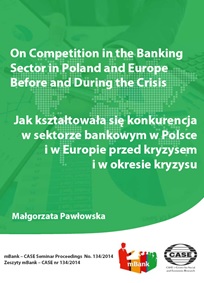On Competition in the Banking Sector in Poland and Europe Before and During the Crisis
 In the past decades, the banking sector has come to be known in literature as the banking industry as it was geared to increasing profits, banks were growing, and banking products developed dynamically. It was believed that competition in the banking sector makes banks more efficient and stimulates financial innovation opening new markets (Bikker and Leuvenstein, 2014).
In the past decades, the banking sector has come to be known in literature as the banking industry as it was geared to increasing profits, banks were growing, and banking products developed dynamically. It was believed that competition in the banking sector makes banks more efficient and stimulates financial innovation opening new markets (Bikker and Leuvenstein, 2014).
The financial crisis of 2007–2008 has sparked the interest of researchers and politicians in competition in the banking sector and its impact on the stability of the financial sector and overall economic growth. However, researchers cannot agree whether more competition improves or hinders stability. According to some economists, excessive increase of competition, financial innovations in the market, as well as inadequate regulation triggered the global financial crisis; they explain this with the fact that more competition makes banks accept more risks (World Bank Report, 2012). According to other economists, more competition improves financial stability by crowding unstable banks out of the market (Bikker and Leuvenstein, 2014). Post-crisis competition literature addresses the question of whether competition in the banking sector has a positive impact and what is the role of regulatory policy in relation to banks and competition policy. Other relevant issues include ownership transition which has occurred in parallel to further consolidation and government intervention in the banking sector (see e.g. Beck et al. (2010), World Bank Report (2013)). After Lehman Brothers, governments saved many banks with capital injections (including the Royal Bank of Scotland (RBS)) while other banks were nationalised (e.g. ABN AMRO, HypoVereinBank), which distorted competition.
The great role played the financial sector in the economy, as demonstrated by the recent crisis, has raised the question of the role of government intervention in the EU banking sectors and bailing out banks in distress with taxpayers’ money (e.g. Barry, 2010; Beck et al., 2010). Another important question concerns changes in competition over time, i.e., how competition in the EU banking sectors evolved before and during the financial crisis: did competition improve or decline in view of the emergence of huge banks and increased concentration in the EU banking sectors?
The purpose of this paper is to present empirical results of research on competition measured in the Polish and European banking sector before and during the crisis using the methods of bank competition theory known in English language literature as the Industrial Organization Approach of Banking (IOAB). The paper presents the results of my own research on competition and concentration in the Polish banking sector in the period before and during the crisis, as well as the results of other research on the banking sectors of EU Member States. The paper also raises the issue of the role of competition in the banking sector and its impact on stability of the banking sector and economic growth. The paper also covers the key drivers of competition in the banking sector.
This paper was presented by Małgorzata Pawłowska during the 134th mBank-CASE Seminar "The global financial crisis: changes in competition in the banking sector in Europe, the role of regulation and intervention by governments and central banks".
* mBank–CASE Seminar Proceedings are continuation of PBR–CASE and, since 1998, BRE Bank–CASE Seminar Proceedings Series.
**Don't miss the upcoming mBank - CASE Seminars - sign up for our newsletter and follow us on facebook!
